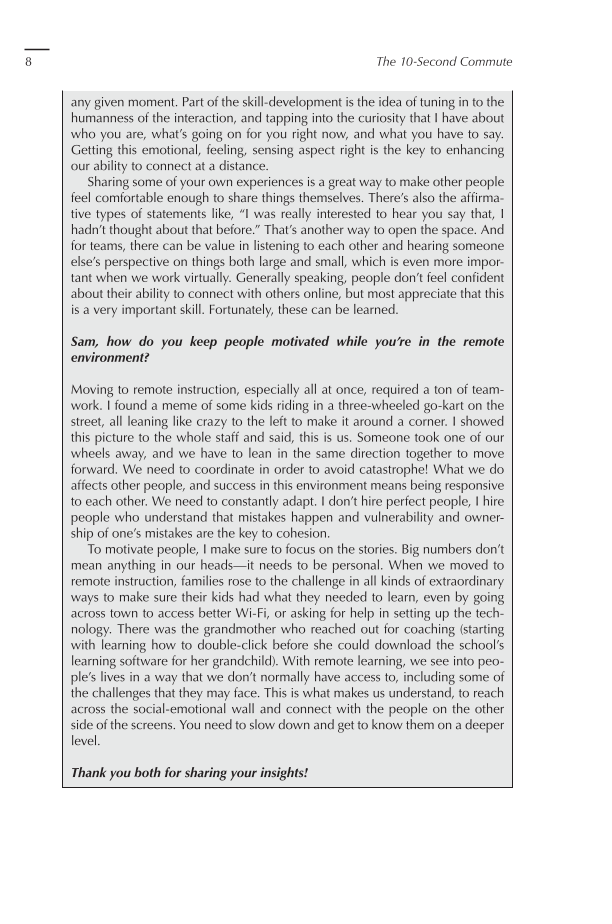8 The 10-Second Commute any given moment. Part of the skill-development is the idea of tuning in to the humanness of the interaction, and tapping into the curiosity that I have about who you are, what’s going on for you right now, and what you have to say. Getting this emotional, feeling, sensing aspect right is the key to enhancing our ability to connect at a distance. Sharing some of your own experiences is a great way to make other people feel comfortable enough to share things themselves. There’s also the affirma- tive types of statements like, “I was really interested to hear you say that, I hadn’t thought about that before.” That’s another way to open the space. And for teams, there can be value in listening to each other and hearing someone else’s perspective on things both large and small, which is even more impor- tant when we work virtually. Generally speaking, people don’t feel confident about their ability to connect with others online, but most appreciate that this is a very important skill. Fortunately, these can be learned. Sam, how do you keep people motivated while you’re in the remote environment? Moving to remote instruction, especially all at once, required a ton of team- work. I found a meme of some kids riding in a three-wheeled go-kart on the street, all leaning like crazy to the left to make it around a corner. I showed this picture to the whole staff and said, this is us. Someone took one of our wheels away, and we have to lean in the same direction together to move forward. We need to coordinate in order to avoid catastrophe! What we do affects other people, and success in this environment means being responsive to each other. We need to constantly adapt. I don’t hire perfect people, I hire people who understand that mistakes happen and vulnerability and owner- ship of one’s mistakes are the key to cohesion. To motivate people, I make sure to focus on the stories. Big numbers don’t mean anything in our heads—it needs to be personal. When we moved to remote instruction, families rose to the challenge in all kinds of extraordinary ways to make sure their kids had what they needed to learn, even by going across town to access better Wi-Fi, or asking for help in setting up the tech- nology. There was the grandmother who reached out for coaching (starting with learning how to double-click before she could download the school’s learning software for her grandchild). With remote learning, we see into peo- ple’s lives in a way that we don’t normally have access to, including some of the challenges that they may face. This is what makes us understand, to reach across the social-emotional wall and connect with the people on the other side of the screens. You need to slow down and get to know them on a deeper level. Thank you both for sharing your insights!
Document Details My Account Print multiple pages
Print
You have printed 0 times in the last 24 hours.
Your print count will reset on at .
You may print 0 more time(s) before then.
You may print a maximum of 0 pages at a time.









































































































































































































